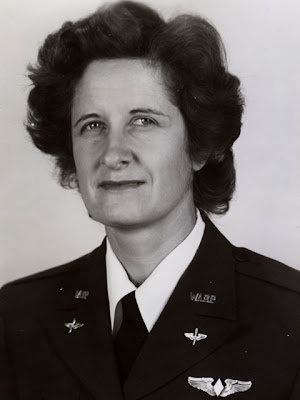“Listening to my father describe a flight he took with a barnstormer at a county fair doing the “loop the loop” made me determined to fly some day.”
WASP Eleanor Thompson Wortz
Eleanor Thompson was born
on June 5, 1921 in the small North Carolina town of Salisbury, 50 miles southwest
of Greensboro. From her earliest recollection of her dad sharing exciting
stories of flying with a barnstormer, Eleanor was determined to learn to
fly.
After graduating from
Spencer High School, she attended from Catawba College in Salsbury where she
became Chief Cheerleader, was a member of the Writer’s Club and Editor of the
College Annual. While in college, she was able to take advantage
of the Civilian Pilot Training offered to students, as the only girl in a class
of ten, finally fullfilling her childhood dream to learn to fly. She
graduated with a BS in Business Administration, a Teacher’s Certificate and a
Private Pilot License.
After graduation, Eleanor
worked as a clerk-typist for the Civil Aeronautics Administration in
Washington, DC. While at the CAA, she received a telegram from Jacqueline
Cochran, inviting her to apply for the new military flying raining program for
women pilots. She applied and was accepted into class 43-W-4.
Eleanor paid her way to
Sweetwater, Texas. On Valentine’s Day,
1943, she and one hundred fifty other hopeful young female pilots, reported for
training at Avenger Field. After just five months of training, Eleanor
and one hundred and eleven classmates graduated and earned their silver WASP
wings. It was the largest WASP graduating class in history.
After graduation, Eleanor
was sent to the 5th Ferrying Group at Love Field, Dallas, Texas. While at
Love Field, she qualified as a first pilot for Class III aircraft, which
included the larger twin engine C-47’s. After a year at Love Field, she
was transferred to Victorville Army Air Base in Victorville, California,
where she flew AT-11’s as an engineering test pilot.
After the WASP were
deactivated, Eleanor flew war surplus aircraft to new owners. She then
accepted a job as Asst. to the Registrar at Stanford University.
Shortly afterwards, she was given the opportunity to travel and took a job
teaching ‘Theory Of Flight’ and ‘Math’
at Escola Technica de Aviacao in Sao Paulo, Brazil, and English at the State Department School. In
1946, after a courtship that started in a Portugese language class jn Coral
Gables, Florida, she married James
Howard Wortz, a fellow instructor.
The young couple returned
to the States and settled in California, where they built a home. Their family
grew to include two sons: Marc Steven and William Howard.
Eleanor ran the training
division at Moffett Field, California for six years and earned her MA from San
Jose State University. She taught business at Canada College, Redwood,
California until she retired at age sixty-two.
Following her husband’s
death in 1990, Eleanor organized the Woodland Vista Swim and Racquet Club in
Los Altos and served as the first president.
Eleanor travelled
to Europe, the Middle East, Asia, Africa, Australia and South America. She was a long-time member of the Los Altos
United Methodist Church.
In 2010, Eleanor and her
sister WASP were awarded the Congressional Gold Medal, the highest civilian
honor Congress can bestow. Less than a year later, her memoir, “Fly Gals of World War II”, was published.
Eleanor died peacefully
at her home in Los Altos, California on August 18, 2013 at the age of ninety
two.
From her official
obituary:
“She will be dearly missed by her loving sons, Marc Steven Wortz of Santa Cruz and William Howard Wortz of Los Gatos, and their wives, Cathy and Fujko, as well as brother Julian Thompsoin of Potomac Falls, Virginia, sister Jean Thompson Barrick of Los Gatos, and many nieces, nephews, and friends.”
God bless the family of
this extraordinary WASP and all of those around the world, whose lives she
touched.
Respectfully written and
posted by Nancy Parrish
sources:
“Out of the Blue and Into History” by WASP Betty Turner p. 85
Official obituary --Legacy.com

















